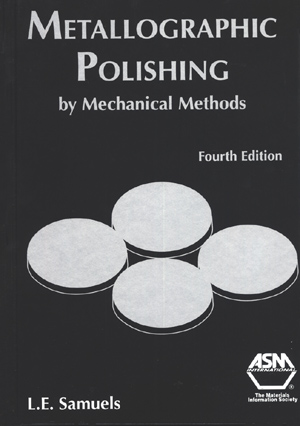“Metallographic Polishing by Mechanical Methods”, Fourth Ed. by Leonard E. Samuals
Metallographic Polishing by Mechanical Methods
Fourth Edition, by Leonard E. Samuels.
ASM International, 9639 Kinsman Road, Materials Park, OH 44073-0002 (2003).
ISBN: 0-87170-779-9.
Orders: 800-336-5152; FAX 440-338-4634; www.asminternational.org.
345 pages; illustrated. Hard cover. US$149.00; ASM members US$120.00.

A number of advances have been made in understanding the formation of inhomogeneous structures during the plastic deformation of metals at large strains since the publication of the Third Edition of this book in 1982. Amongst these advances is the knowledge that the periodic formation of bands of intense shear is intrinsic to the formation of machining chips, and parts of these bands become incorporated into the newly generated surface. This knowledge now allows clarification of layer features. Also, finer grades of diamond abrasive used for polishing are now recognized to remove material not through micromachining, but by some yet undefined mechanism. Changes to the surface structure using these finer diamond abrasives are almost inconsequential. Additionally, new polishing processes using extremely fine spherical silica particles produce deformation-free surfaces. All of these have led to the devising of normal preparation procedures that are much simpler than those used in the past, and these have been incorporated into this new edition. Apparatus for the semi-automatic preparation of specimens has further developed since the last edition, particularly involving new types of abrasion and polishing devices, and the manner of applying abrasives to them.
The book begins with a brief, laudatory biography of the author written by George Vander Voort, in which Samuels’ publications, honors, and professional positions are traced from the first publication of this book in 1967, through his retirement in 1983, to his honors up through 1994.
This Fourth Edition is divided into 12 chapters, concluding with a Glossary and Index. The introductory chapter relates the foundations of metallography, the early developments of preparation methods, and the practical methods of producing representative surfaces. An Appendix on Sorby appropriately concludes the chapter.
Chapter 2 is devoted to Sectioning and Mounting, in which consideration is given to sectioning, specimen mounting, mounting in plastic cylinders; abrasion rates and polishing rates; electrical conductivity, molding methods for thermoplastics and casting plastics; mounting of small and thin specimens; marking for identification; and removal of specimens from mounts. Five appendices conclude the chapter; they include plating methods, silvering, preparing a conducting plastic, and methods of mold making.
Chapter 3 discusses the principles of machining with abrasives; Chapter 4 discusses the practice of machining with abrasives; and Chapter 5 discusses surface damage in machining with abrasives.
Chapter 6 is devoted to non-abrasive preparation processes, including etch cutting and marking; spark cutting and machining; and microtome cutting and micromilling.
Chapter 7 discusses the principles of polishing with abrasives, and Chapter 8 discusses surface damage in polishing with abrasives.
Chapter 9 deals with all of the above principles as they apply to brittle materials.
Chapter 10 presents the principles of the design of manual preparation systems; Chapter 11 discusses the modifications required to manual preparation systems.
The final chapter is devoted to the design of semi-automatic preparation systems.
Although this book is addressed to the preparation of metal specimens, all industrial and materials sciences laboratories deal, on a daily basis, with samples of all kinds, which require the same kinds of optical and chemical study and, therefore, have a need to apply these same techniques to both metal and non-metal specimens. The principles and practices described in this classic textbook will be of material benefit to anyone needing to section, mount, machine and polish almost any sample – as it has been for the last 35 years.
Comments
add comment